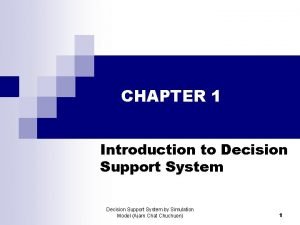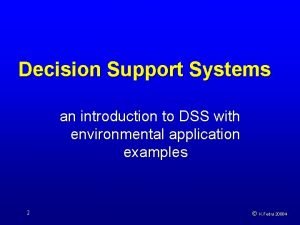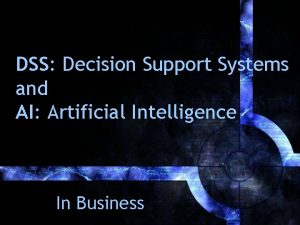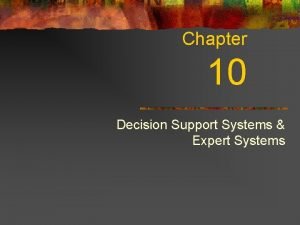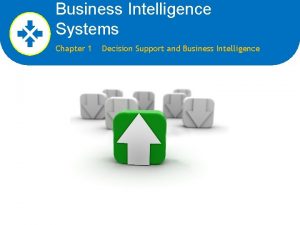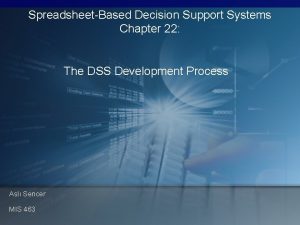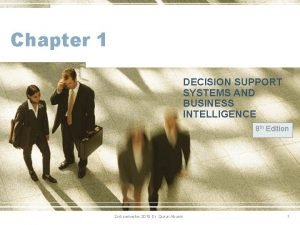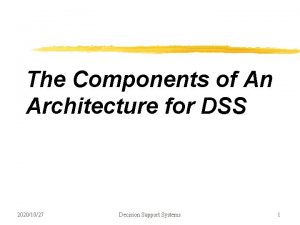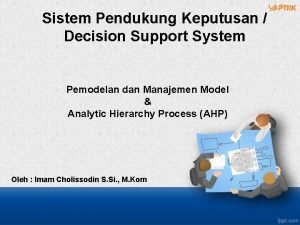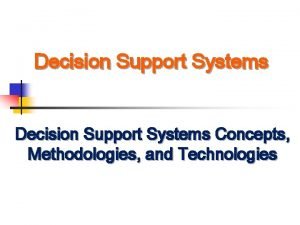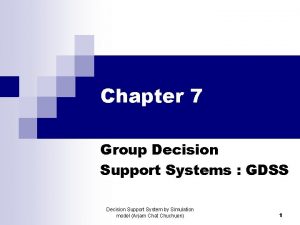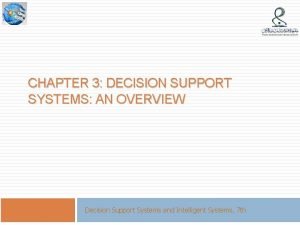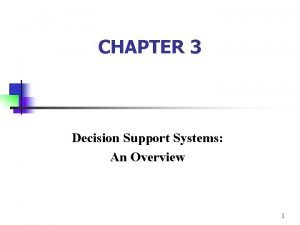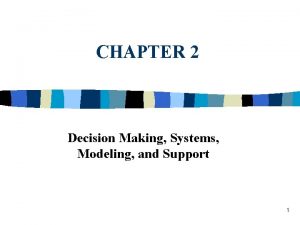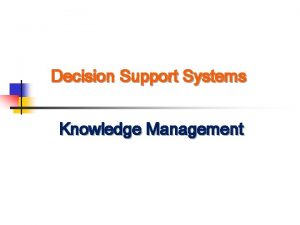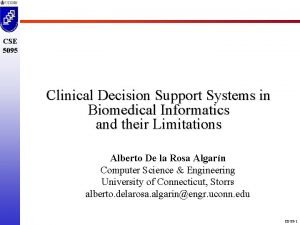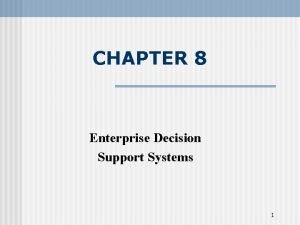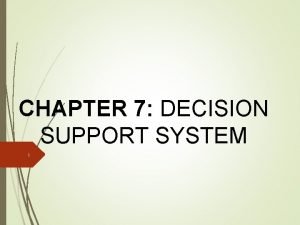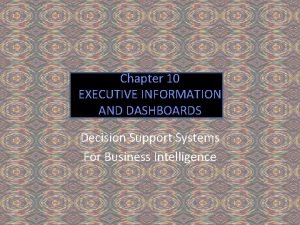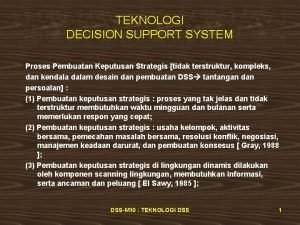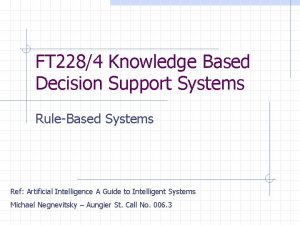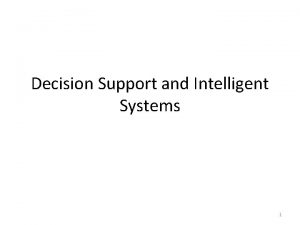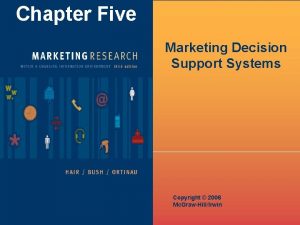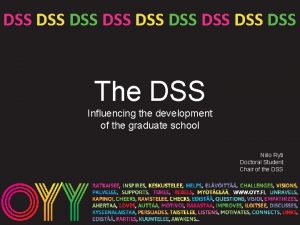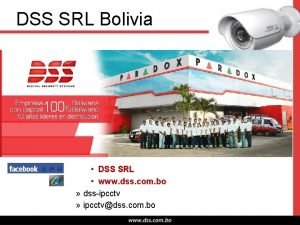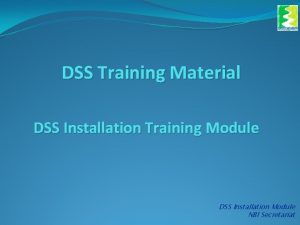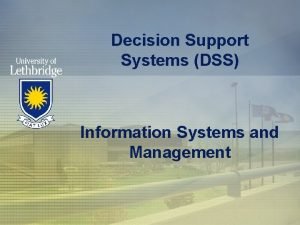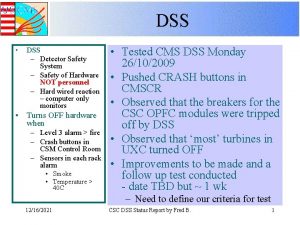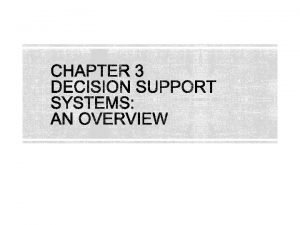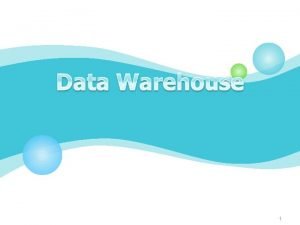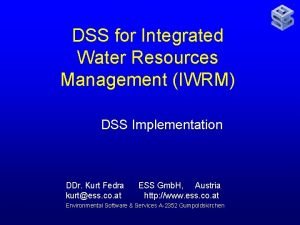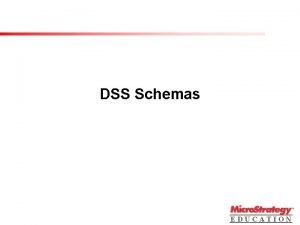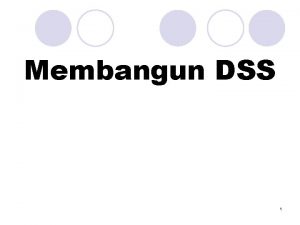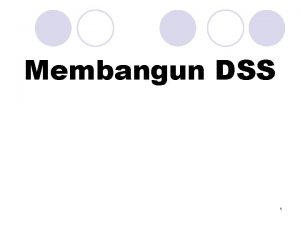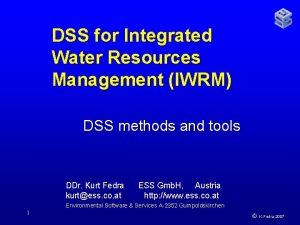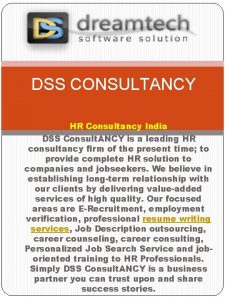Decision Support System Introduction Decision Support Systems DSS






























- Slides: 30

Decision Support System


Introduction

Decision Support Systems (DSS) are a specific class of computerized information systems that form the backbone of an organization’s decision making process supports business and organizational decision- making activities By giving direct computer support to managers during the decision making process

Objectives Of DSS • To increase effectiveness of the manager’s decision process • Supports the manager in the decision-making process but does not replace it

Characteristics

FACILITATION REPEATED USE INTERACTION IDENTIFIABLE ANCILLARY TASK- ORIENTED

DECISION IMPACT SUPPORTS INDIVIDUAL & GROUP DECISIONMAKING COMPREHENSIVE DATA ACCESS

EASY TO DEVELOP & DEPLOY INTEGRATED SOFTWARE FLEXIBILITY

Component s

DATA MANAGEMENT MODEL MANAGEMENT KNOWLEDGE MANAGEMENT USER INTERFACE MANAGEMENT

Data Management • Performs the function of storing and maintaining the information that you want your Decision Support System to use

Data Management Sources of Information: • Organizational Information • External Information • Personal Information

Model Management • Consists of both the Decision support system models and the Decision Support System model management system.

Decision Support System Model • • What-if Analysis Optimization Models Goal-seeking Models Statistical Models

Model Management System • stores and maintains the Decision Support System models

User Interface Management • The only component of the system with which you have direct contact User Interface • the part of the system you see through it when you enter information, commands, and models.

Characteristics Of A Best User Interface • • • Uses your terminology and methods Flexible Consistent Simple Adaptable

Knowledge Management Component • Provides information about the relationship among data that use too complex for a database to represent.

Typ es

Communication- Driven • • Targeted at internal teams, including partners Enables cooperation, supporting more than one person working on a shared task Data- Driven • Targeted at managers, staff and also product or service suppliers • It is used to query a database warehouse to seek specific answers for specific purposes

Document- Driven • Targeted at a broad base of user groups • The purpose is to search web pages and find documents on a specific set of keywords or search items Knowledge- Driven • ’Knowledgebase’ are a catch-all category covering a broad range of systems covering users within the organization setting it up but also may include others interacting with the organization

Model- Driven • Emphasizes access to and manipulation of a statistical, financial, optimization, or simulation model • Used by managers and staff members of a business

Advantages

TIME SAVINGS IMPROVES EFFICIENCY IMPROVE INTERPERSONAL COMMUNICATION COMPETITIVE ADVANTAGE

COST REDUCTION INCREASE DECISION MAKER SATISFACTION PROMOTE LEARNING INCREASED ORGANIZATIONAL CONTROL

Disadvantages

MONETARY COST OVEREMPHASIZE DECISION MAKING ASSUMPTION OF RELEVANCE TRANSFER OF POWER

UNANTICIPATED EFFECTS OBSCURING RESPONSIBLITY FALSE BELIEF IN OBJECTIVITY STATUS REDUCTION

SYSTEM DESIGN FAILURE DIFFICULTY IN COLLECTING ALL THE REQUIRED DATA
 Decision support systems and intelligent systems
Decision support systems and intelligent systems Decision chapter 1
Decision chapter 1 Introduction to decision support system
Introduction to decision support system Decision support system vs expert system
Decision support system vs expert system Expert system and decision support system
Expert system and decision support system Decision support system and expert system
Decision support system and expert system No decision snap decision responsible decision
No decision snap decision responsible decision Dividend decision in financial management
Dividend decision in financial management Mdm support technologies in dss
Mdm support technologies in dss Dss systems & software technologies ltd
Dss systems & software technologies ltd Decision support and business intelligence systems
Decision support and business intelligence systems Developing spreadsheet-based decision support systems
Developing spreadsheet-based decision support systems Decision support system in business intelligence
Decision support system in business intelligence Types of information systems
Types of information systems Components of decision support system
Components of decision support system Contoh spk motor honda
Contoh spk motor honda Components of decision support system
Components of decision support system Components of group decision support system
Components of group decision support system Characteristics of a decision support system
Characteristics of a decision support system Components of decision support system
Components of decision support system Types of decision support system
Types of decision support system Model driven decision support system
Model driven decision support system Decision support system in knowledge management
Decision support system in knowledge management Iliad clinical decision support system
Iliad clinical decision support system Enterprise decision support system
Enterprise decision support system Objectives of decision support system
Objectives of decision support system Chapter 10
Chapter 10 Proses decision support system
Proses decision support system Knowledge based decision support system
Knowledge based decision support system Benefits of decision support system
Benefits of decision support system Mdss in marketing
Mdss in marketing

